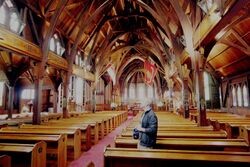Sarking
Topic: Engineering
 From HandWiki - Reading time: 2 min
From HandWiki - Reading time: 2 min
Sarking is an English word with multiple meanings in roof construction:
- The use of wood panels, or "sarking boards", called sheathing, sheeting or decking in American English, under the roof-covering materials such as the shingles of a roof to provide support. It is a common term in Scotland, Australia , and New Zealand. The shingles or slates are nailed directly to the sarking boards without timber battens, providing a strong, wind-resistant roof.
- An additional layer within a roof that insulates or reflects heat, such as a layer of felt, reflective foil, or polystyrene.
- Roofing felt or other type of underlayment (Am. English) under the roof covering for extra resistance to leakage.
- The word sarking is further used as part of the term scrim and sarking, a method of interior construction widely used in Australia and New Zealand in the late 19th and early 20th centuries.
- In modern usage of the term in Australia, sarking refers to a laminated aluminium foil layer, or reflective foil laminate (RFL), that is installed on the roof trusses, beneath the battens, supporting a tile or metal deck roof. It acts as additional radiative (radiant barrier) and convective insulation and provides a condensation barrier.[1]
In New Zealand, both corrugated metal and asbestos-cement shingle roofs were fitted directly over wooden sarking boards in the historical "bungalow" style of house construction.[2][3]
See also
References
- ↑ For example, see http://www.homeimprovementpages.com.au/article/reflective_foil_sarking
- ↑ "Bungalow: Roof framing and gutters: original details". BRANZ. https://www.renovate.org.nz/bungalow/roofs/roof-framing-and-gutters-original-details/.
- ↑ "Bungalow: Roof cladding: original details". BRANZ. https://www.renovate.org.nz/bungalow/roofs/roof-cladding-original-details/.
 |
Licensed under CC BY-SA 3.0 | Source: https://handwiki.org/wiki/Engineering:Sarking
35 views | Status: cached on July 16 2024 12:21:00
↧ Download this article as ZWI file
35 views | Status: cached on July 16 2024 12:21:00
↧ Download this article as ZWI file
 KSF
KSF
